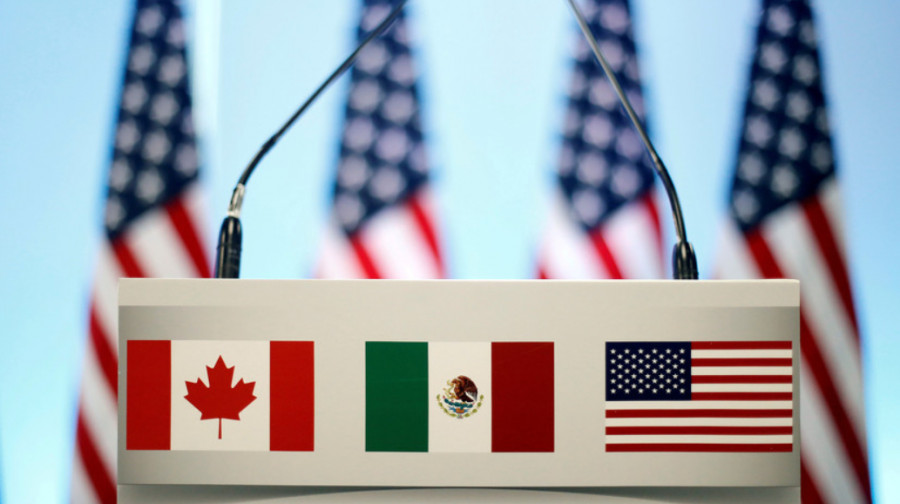Economic front heats up
President Donald Trump's new 25% tariffs on imports from Mexico and Canada took effect Tuesday, along with fresh tariffs on goods from China. The measures have exacerbated already tense trade relations, raising concerns about slowing economic growth and rising prices for Americans who have long struggled with high inflation.
Will the US soften the tariff blow for loyal companies?
Commerce Secretary Howard Lutnick said that President Trump is considering partially softening the new tariffs for those companies that strictly follow the rules of the North American Free Trade Agreement (USMCA). This agreement, which regulates trade between the United States, Canada, and Mexico, is subject to revision in 2026, and the new tariff policy could be an important card in future negotiations.
Canada, Mexico Prepare Response
Canadian Prime Minister Justin Trudeau made no secret of his outrage, calling the new tariffs "ill-considered and harmful." In response, Ottawa imposed mirror tariffs of 25% on C$30 billion (US$20.7 billion) worth of American goods. The retaliatory measures include popular items including orange juice, peanut butter, alcohol, coffee, appliances and even motorcycles.
Mexican President Claudia Sheinbaum has also promised retaliatory measures, but has not yet provided details. She said she would announce Mexico's response on Sunday, leaving room for diplomatic maneuvering.
Financial Markets Are Fevered
Lutnick's statements about possible concessions caused a temporary rise in the Canadian dollar and the Mexican peso, which had previously fallen sharply on the news of tariffs. However, the overall effect of Trump's tariff strike was much stronger - global stock markets responded with a strong sell-off in shares, reflecting investors' fears of an escalation of trade conflicts.
China Strikes Back
Beijing did not take long to respond. In response to Washington's actions, China announced the introduction of new 10%-15% tariffs on certain American goods from March 10, as well as additional export restrictions for a number of American companies. Moreover, China has filed a formal complaint with the World Trade Organization (WTO), which could trigger another round of trade disputes.
All this only exacerbates global tensions and pushes the world towards a full-scale trade war. How far are the US and its opponents willing to go? The answer to this question will determine the economic fate of the coming years.
Canada Goes All-In: Threat of Additional Tariffs
Canadian Prime Minister Justin Trudeau has made it clear that Ottawa will not tolerate trade barriers imposed by Washington. If the new US tariffs are not lifted within 21 days, Canada will impose additional tariffs worth CAD 125 billion. Key sectors of the American economy, including the automotive industry, metallurgy, aviation, as well as beef and pork exports, could be hit.
In addition, Canada plans to challenge the US actions at the international level - within the framework of the World Trade Organization (WTO) and the provisions of the US-Canada-Mexico Free Trade Agreement (USMCA).
Ontario vs. Washington: A Hit on Contracts
The Premier of Canada's largest province, Ontario, Doug Ford, went even further. He canceled a CAD 100 million contract with Elon Musk's Starlink satellite network and also imposed a ban on concluding government contracts with American companies.
But the main lever of pressure may be energy: if the US tariffs remain in force, Ontario will introduce a 25% surcharge on electricity exports to the US. Such a move could significantly increase the cost of electricity in several US states dependent on Canadian supplies.
Rising prices in the US: the effect is the opposite of expectations
Although Donald Trump promised Americans a reduction in the cost of living, his trade policy has already led to an increase in prices. Retailers warn that consumers will soon feel the blow to their wallets.
Target CEO Brian Cornell told CNBC that in the coming days, the chain will begin raising prices on seasonal goods, in particular, avocados supplied from Mexico.
Best Buy has also expressed concern. According to its CEO Corey Barry, a significant portion of the electronics in the chain's assortment are made in China and Mexico. If the tariff pressure continues, the cost of gadgets on the American market will inevitably increase.
Tech Blow: New Tariffs on Electronics
The Trump administration has announced a 20% tariff on a range of high-tech products from China that were previously exempt from tariff sanctions. The list includes key categories:
- Smart watches and smart speakers;
These measures could have a major impact on the consumer market, since most of the world's electronics are made in China. Companies like Apple, Dell, and Microsoft could be forced to either cut profits or pass on increased costs to customers.
New Tariffs: US-China Trade War Reaches New Level
An additional 10% tariff on Chinese imports that went into effect Tuesday was the latest round of economic confrontation between Washington and Beijing. The measures complemented a similar 10% tariff imposed by Trump on February 4 and were superimposed on the existing 25% tariffs introduced during his first term as president.
As a result, imports of a number of Chinese goods are now subject to maximum tariffs, making them significantly more expensive for American consumers and businesses.
China's Response: A Blow to American Agriculture
Beijing did not leave Washington's actions unanswered. The new Chinese tariffs are aimed at the agricultural sector, which is vital for the United States. The following items were hit:
- Meat (beef, pork, poultry);
- Grains (corn, soybeans, wheat);
These measures could be a serious test for American farmers, who have already suffered from previous trade wars. Let us recall that during Trump's first term, trade conflicts with China cost the US agricultural sector about $27 billion in lost revenue. A significant part of the Chinese market then went to Brazil, which put American farmers in a difficult position.
The North American economy is under threat
The US, Canada and Mexico are closely related economies, where supply chains have long been intertwined. New tariffs on Mexican and Canadian goods could not only hit exporters, but also destabilize the economic growth of the entire region.
The Federal Reserve Bank of Atlanta has already recorded a sharp revision of its forecasts for US GDP. According to the latest data from GDPNow, instead of the expected growth of 2.3% in the first quarter, a decline of 2.8% is now predicted. This indicates that the tariff policy could lead to a recession earlier than expected.
Is Europe emerging from crisis? German markets are recovering from the fall
While American and Asian markets are reeling from tariff battles, European stock exchanges are showing signs of recovery. After its worst day in six months, the German DAX index jumped 2.6% on Wednesday morning.
The rise was fueled by the decision of the German authorities to ease the so-called "debt brake" - a mechanism that limits government spending. This step could give the German economy an additional boost, helping to avoid a recession.
Despite local successes in Europe, global markets remain tense. A new phase of the trade war between the United States, China, Canada and Mexico could trigger a full-scale economic crisis, the consequences of which will be felt across the world.
European markets recover from a sharp fall
The pan-European STOXX 600 index showed a confident rise of 1.1% on Wednesday, recovering losses after its worst day since August 2024. The collapse came as US President Donald Trump imposed 25% tariffs on imports from Canada and Mexico, causing a wave of anxiety among investors. However, optimism returned thanks to news from Germany, where politicians agreed on significant measures to support the economy.
Germany to invest €500 billion in infrastructure
Germany's main political forces have agreed to create an infrastructure fund worth €500 billion (equivalent to $534 billion). This measure is aimed at strengthening the country's defense budget and stimulating economic growth. In addition, Germany will ease fiscal restrictions, which will give the government more room for budget maneuver and increase public spending.
The news caused the yield on 10-year German bonds to rise by 20 basis points to 2.680%, indicating increased expectations for economic growth and inflation.
Growth in the construction and defense sectors
Plans for large-scale infrastructure financing have given a strong boost to Germany's construction industry. The largest companies in the sector showed significant growth:
- Heidelberg Materials (+7.8%) – one of the leaders in the global cement market;
- Bilfinger (+11.7%) – a supplier of industrial services, including construction;
- Hochtief (+7.6%) – a leading construction company.
The defense industry did not stand aside either. Increased defense spending helped Rheinmetall (+1.3%) and Renk (+5.5%) strengthen their positions.
The banking sector shows confident growth
The European banking index SX7E became the fastest growing among all sectors, rising by 4%. Expectations of increased government spending and potential easing of the monetary policy of the European Central Bank (ECB) create favorable conditions for the growth of financial institutions.
Adidas loses ground amid slowing sales
Despite the overall improvement in market sentiment, Adidas faced a negative reaction from investors. Shares in the sportswear giant fell 3.3% after the company warned that sales growth would slow to 10% in 2025. That was below analysts' expectations, raising concerns about the company's future financial results.
Markets await further cues
While European stocks have shown a partial recovery, uncertainty over the US trade war, fiscal policy shifts in Europe and fluctuations in global demand continue to weigh on markets. The key factors in the coming weeks will be how the US, Canada and Mexico respond to the escalating trade conflict, as well as how European governments will take further steps on public spending.











